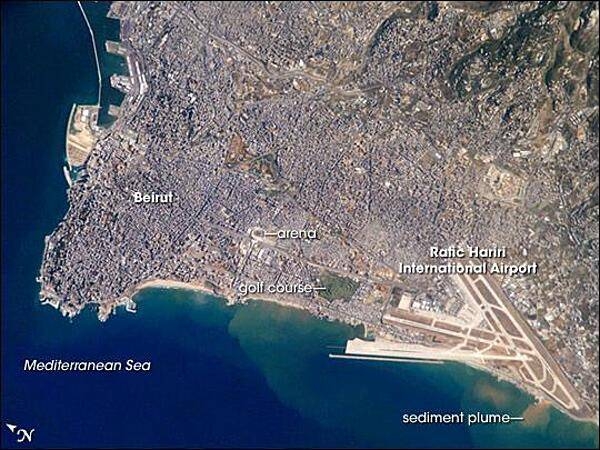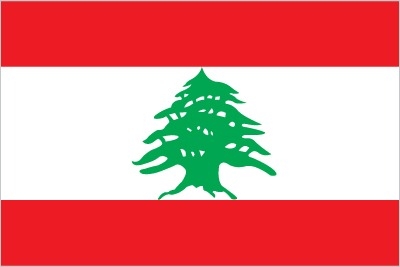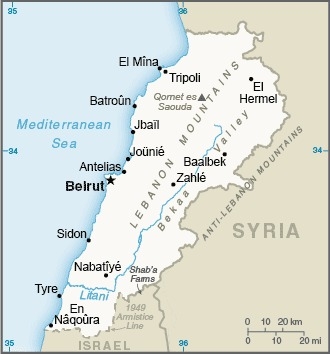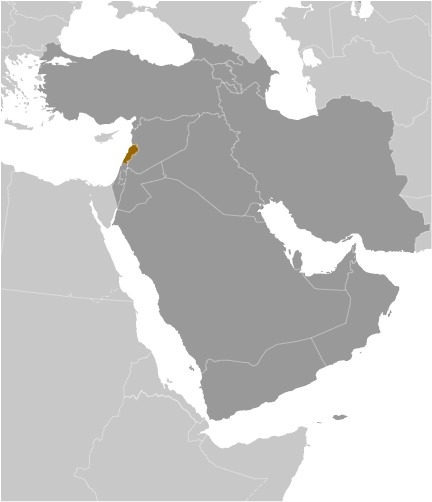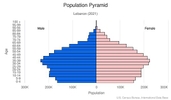Introduction
Background
Following World War I, France acquired a mandate over the northern portion of the former Ottoman Empire province of Syria. The French demarcated the region of Lebanon in 1920 and granted this area independence in 1943. Since independence, the country has been marked by periods of political turmoil interspersed with prosperity built on its position as a regional center for finance and trade. The country's 1975-90 civil war, which resulted in an estimated 120,000 fatalities, was followed by years of social and political instability. Sectarianism is a key element of Lebanese political life. Neighboring Syria has historically influenced Lebanon's foreign policy and internal policies, and its military occupied Lebanon from 1976 until 2005. The Lebanon-based Hizballah militia and Israel continued attacks and counterattacks against each other after Syria's withdrawal, and fought a brief war in 2006. Lebanon's borders with Syria and Israel remain unresolved.
Visit the Definitions and Notes page to view a description of each topic.
Geography
Location
Middle East, bordering the Mediterranean Sea, between Israel and Syria
Geographic coordinates
33 50 N, 35 50 E
Map references
Middle East
Land boundaries
total: 484 km
border countries (2): Israel 81 km, Syria 403 km
Coastline
225 km
Maritime claims
territorial sea: 12 nm
Climate
Mediterranean; mild to cool, wet winters with hot, dry summers; the Lebanon Mountains experience heavy winter snows
Terrain
narrow coastal plain; El Beqaa (Bekaa Valley) separates Lebanon and Anti-Lebanon Mountains
Elevation
highest point: Qornet es Saouda 3,088 m
lowest point: Mediterranean Sea 0 m
mean elevation: 1,250 m
Natural resources
limestone, iron ore, salt, water-surplus state in a water-deficit region, arable land
Land use
agricultural land: 63.3% (2018 est.)
arable land: 11.9% (2018 est.)
permanent crops: 12.3% (2018 est.)
permanent pasture: 39.1% (2018 est.)
forest: 13.4% (2018 est.)
other: 23.3% (2018 est.)
Irrigated land
1,040 sq km (2012)
Population distribution
the majority of the people live on or near the Mediterranean coast, and of these most live in and around the capital, Beirut; favorable growing conditions in the Bekaa Valley, on the southeastern side of the Lebanon Mountains, have attracted farmers and thus the area exhibits a smaller population density
Natural hazards
earthquakes; dust storms, sandstorms
Geography - note
smallest country in continental Asia; Nahr el Litani is the only major river in Near East not crossing an international boundary; rugged terrain historically helped isolate, protect, and develop numerous factional groups based on religion, clan, and ethnicity
People and Society
Nationality
noun: Lebanese (singular and plural)
adjective: Lebanese
Ethnic groups
Arab 95%, Armenian 4%, other 1%
note: many Christian Lebanese do not identify themselves as Arab but rather as descendants of the ancient Canaanites and prefer to be called Phoenicians
Languages
Arabic (official), French, English, Armenian
major-language sample(s):
كتاب حقائق العالم، المصدر الذي لا يمكن الاستغناء عنه للمعلومات الأساسية (Arabic)
The World Factbook, the indispensable source for basic information.
Religions
Muslim 67.8% (31.9% Sunni, 31.2% Shia, smaller percentages of Alawites and Ismailis), Christian 32.4% (Maronite Catholics are the largest Christian group), Druze 4.5%, very small numbers of Jews, Baha'is, Buddhists, and Hindus (2020 est.)
note: data represent the religious affiliation of the citizen population (data do not include Lebanon's sizable Syrian and Palestinian refugee populations); 18 religious sects recognized
Age structure
0-14 years: 20.75% (male 581,015/female 554,175)
15-24 years: 14.98% (male 417,739/female 401,357)
25-54 years: 46.69% (male 1,296,250/female 1,257,273)
55-64 years: 9.62% (male 250,653/female 275,670)
65 years and over: 7.96% (male 187,001/female 248,479) (2020 est.)
Dependency ratios
total dependency ratio: 48.4
youth dependency ratio: 37.2
elderly dependency ratio: 11.2
potential support ratio: 8.9 (2020 est.)
Median age
total: 33.7 years
male: 33.1 years
female: 34.4 years (2020 est.)
Population distribution
the majority of the people live on or near the Mediterranean coast, and of these most live in and around the capital, Beirut; favorable growing conditions in the Bekaa Valley, on the southeastern side of the Lebanon Mountains, have attracted farmers and thus the area exhibits a smaller population density
Urbanization
urban population: 89.1% of total population (2021)
rate of urbanization: -1.23% annual rate of change (2020-25 est.)
Major urban areas - population
2.435 million BEIRUT (capital) (2021)
Sex ratio
at birth: 1.05 male(s)/female
0-14 years: 1.05 male(s)/female
15-24 years: 1.04 male(s)/female
25-54 years: 1.03 male(s)/female
55-64 years: 0.91 male(s)/female
65 years and over: 0.75 male(s)/female
total population: 1 male(s)/female (2020 est.)
Maternal mortality ratio
29 deaths/100,000 live births (2017 est.)
country comparison to the world: 112Infant mortality rate
total: 7.2 deaths/1,000 live births
male: 7.78 deaths/1,000 live births
female: 6.6 deaths/1,000 live births (2021 est.)
Life expectancy at birth
total population: 78.53 years
male: 77.12 years
female: 80 years (2021 est.)
Drinking water source
improved: total: 100% of population
unimproved: total: 0% of population (2017 est.)
Current Health Expenditure
8.4% (2018)
Physicians density
2.1 physicians/1,000 population (2018)
Hospital bed density
2.7 beds/1,000 population (2017)
Sanitation facility access
improved: total: 99% of population
unimproved: total: 1% of population (2017 est.)
HIV/AIDS - adult prevalence rate
<.1% (2020 est.)
HIV/AIDS - deaths
<100 (2020 est.)
Major infectious diseases
note: widespread ongoing transmission of a respiratory illness caused by the novel coronavirus (COVID-19) is occurring throughout Lebanon; as of 6 October 2021, Lebanon has reported a total of 626,926 cases of COVID-19 or 9,185.13 cumulative cases of COVID-19 per 100,000 population with 122.54 cumulative deaths per 100,000 population; as of 6 October 2021, 24.21% of the population has received at least one dose of COVID-19 vaccine
Literacy
definition: age 15 and over can read and write
total population: 95.1%
male: 96.9%
female: 93.3% (2018)
School life expectancy (primary to tertiary education)
total: 11 years
male: 12 years
female: 11 years (2014)
Unemployment, youth ages 15-24
total: 23.4%
male: 24.5%
female: 21.4% (2019)
Environment
Environment - current issues
deforestation; soil deterioration, erosion; desertification; species loss; air pollution in Beirut from vehicular traffic and the burning of industrial wastes; pollution of coastal waters from raw sewage and oil spills; waste-water management
Environment - international agreements
party to: Biodiversity, Climate Change, Climate Change-Kyoto Protocol, Climate Change-Paris Agreement, Comprehensive Nuclear Test Ban, Desertification, Endangered Species, Hazardous Wastes, Law of the Sea, Nuclear Test Ban, Ozone Layer Protection, Ship Pollution, Wetlands
signed, but not ratified: Environmental Modification, Marine Life Conservation
Air pollutants
particulate matter emissions: 30.67 micrograms per cubic meter (2016 est.)
carbon dioxide emissions: 24.8 megatons (2016 est.)
methane emissions: 3.37 megatons (2020 est.)
Climate
Mediterranean; mild to cool, wet winters with hot, dry summers; the Lebanon Mountains experience heavy winter snows
Land use
agricultural land: 63.3% (2018 est.)
arable land: 11.9% (2018 est.)
permanent crops: 12.3% (2018 est.)
permanent pasture: 39.1% (2018 est.)
forest: 13.4% (2018 est.)
other: 23.3% (2018 est.)
Urbanization
urban population: 89.1% of total population (2021)
rate of urbanization: -1.23% annual rate of change (2020-25 est.)
Revenue from forest resources
forest revenues: 0% of GDP (2018 est.)
country comparison to the world: 180Major infectious diseases
note: widespread ongoing transmission of a respiratory illness caused by the novel coronavirus (COVID-19) is occurring throughout Lebanon; as of 6 October 2021, Lebanon has reported a total of 626,926 cases of COVID-19 or 9,185.13 cumulative cases of COVID-19 per 100,000 population with 122.54 cumulative deaths per 100,000 population; as of 6 October 2021, 24.21% of the population has received at least one dose of COVID-19 vaccine
Food insecurity
exceptional shortfall in aggregate food production/supplies:
due to the ongoing financial and economic crisis - in August 2020, the UN Economic and Social Commission for Western Asia estimated that more than 55% of the population lived in poverty, up from 28% in 2019; current figures are likely to be higher due to a fall in households' purchasing power; the already worrisome economic conditions, with increasing unemployment, poverty, and skyrocketing inflation rates, have further worsened due to the COVID‑19 pandemic and the measures introduced to contain the spread of the disease
(2021)Waste and recycling
municipal solid waste generated annually: 2.04 million tons (2014 est.)
municipal solid waste recycled annually: 163,200 tons (2014 est.)
percent of municipal solid waste recycled: 8% (2014 est.)
Total water withdrawal
municipal: 240 million cubic meters (2017 est.)
industrial: 900 million cubic meters (2017 est.)
agricultural: 700 million cubic meters (2017 est.)
Total renewable water resources
4.503 billion cubic meters (2017 est.)
Government
Country name
conventional long form: Lebanese Republic
conventional short form: Lebanon
local long form: Al Jumhuriyah al Lubnaniyah
local short form: Lubnan
former: Greater Lebanon
etymology: derives from the Semitic root "lbn" meaning "white" and refers to snow-capped Mount Lebanon
Government type
parliamentary republic
Capital
name: Beirut
geographic coordinates: 33 52 N, 35 30 E
time difference: UTC+2 (7 hours ahead of Washington, DC, during Standard Time)
daylight saving time: +1hr, begins last Sunday in March; ends last Sunday in October
etymology: derived from the Canaanite or Phoenician word "ber'ot," meaning "the wells" or "fountain," which referred to the site's accessible water table
Administrative divisions
8 governorates (mohafazat, singular - mohafazah); Aakkar, Baalbek-Hermel, Beqaa (Bekaa), Beyrouth (Beirut), Liban-Nord (North Lebanon), Liban-Sud (South Lebanon), Mont-Liban (Mount Lebanon), Nabatiye
Independence
22 November 1943 (from League of Nations mandate under French administration)
National holiday
Independence Day, 22 November (1943)
Constitution
history: drafted 15 May 1926, adopted 23 May 1926
amendments: proposed by the president of the republic and introduced as a government bill to the National Assembly or proposed by at least 10 members of the Assembly and agreed upon by two thirds of its members; if proposed by the National Assembly, review and approval by two-thirds majority of the Cabinet is required; if approved, the proposal is next submitted to the Cabinet for drafting as an amendment; Cabinet approval requires at least two-thirds majority, followed by submission to the National Assembly for discussion and vote; passage requires at least two-thirds majority vote of a required two-thirds quorum of the Assembly membership and promulgation by the president; amended several times, last in 2004
Legal system
mixed legal system of civil law based on the French civil code, Ottoman legal tradition, and religious laws covering personal status, marriage, divorce, and other family relations of the Jewish, Islamic, and Christian communities
International law organization participation
has not submitted an ICJ jurisdiction declaration; non-party state to the ICCt
Citizenship
citizenship by birth: no
citizenship by descent only: the father must be a citizen of Lebanon
dual citizenship recognized: yes
residency requirement for naturalization: unknown
Suffrage
21 years of age; authorized for all men and women regardless of religion; excludes persons convicted of felonies and other crimes or those imprisoned; excludes all military and security service personnel regardless of rank
Executive branch
chief of state: President Michel AWN (since 31 October 2016)
head of government: Prime Minister Hassan DIAB (since 22 October 2020); note - the Lebanese Government is in "caretaker" status
cabinet: Cabinet chosen by the prime minister in consultation with the president and National Assembly
elections/appointments: president indirectly elected by the National Assembly with two-thirds majority vote in the first round and if needed absolute majority vote in a second round for a 6-year term (eligible for non-consecutive terms); last held on 31 October 2016 (next to be held in 2022); prime minister appointed by the president in consultation with the National Assembly; deputy prime minister determined during cabinet formation
election results: Michel AWN elected president in second round; National Assembly vote - Michel AWN (FPM) 83 votes; note - in the initial election held on 23 April 2014, no candidate received the required two-thirds vote, and subsequent attempts failed because the Assembly lacked the necessary quorum to hold a vote; the president was finally elected in its 46th attempt on 31 October 2016
Legislative branch
description: unicameral National Assembly or Majlis al-Nuwab in Arabic or Assemblee Nationale in French (128 seats; members directly elected by listed-based proportional representation vote; members serve 4-year terms); prior to 2017, the electoral system was by majoritarian vote
elections: last held on 6 May 2018 (next to be held in 2022)
election results: percent of vote by coalition - NA; seats by coalition – Strong Lebanon Bloc (Free Patriotic Movement-led) 25; Future Bloc (Future Movement-led) 20; Development and Liberation Bloc (Amal Movement-led) 16; Loyalty to the Resistance Bloc (Hizballah-led) 15; Strong Republic Bloc (Lebanese Forces-led) 15; Democratic Gathering (Progressive Socialist Party-led) 9; Independent Centre Bloc 4; National Bloc (Marada Movement-led) 3; Syrian Social Nationalist Party 3; Tashnaq 3; Kata’ib 3; other 8; independent 4; composition - men 122, women 6, percent of women 4.6%
note: Lebanon’s constitution states the National Assembly cannot conduct regular business until it elects a president when the position is vacant
Judicial branch
highest courts: Court of Cassation or Supreme Court (organized into 8 chambers, each with a presiding judge and 2 associate judges); Constitutional Council (consists of 10 members)
judge selection and term of office: Court of Cassation judges appointed by Supreme Judicial Council, a 10-member body headed by the chief justice, and includes other judicial officials; judge tenure NA; Constitutional Council members appointed - 5 by the Council of Ministers and 5 by parliament; members serve 5-year terms
subordinate courts: Courts of Appeal; Courts of First Instance; specialized tribunals, religious courts; military courts
Political parties and leaders
Al-Ahbash or Association of Islamic Charitable Projects [Adnan TARABULSI]
Amal Movement [Nabih BERRI]
Azm Movement [Najib MIQATI]
Ba’th Arab Socialist Party of Lebanon [Fayiz SHUKR]
Free Patriotic Movement or FPM [Gibran BASSIL]
Future Movement Bloc [Sa'ad al-HARIRI]
Hizballah [Hassan NASRALLAH]
Islamic Actions Front [Sheikh Zuhayr al-JU’AYD]
Kata'ib Party [Sami GEMAYEL]
Lebanese Democratic Party [Talal ARSLAN]
Lebanese Forces or LF [Samir JA'JA]
Marada Movement [Sulayman FRANJIEH]
Progressive Socialist Party or PSP [Walid JUNBLATT]
Social Democrat Hunshaqian Party [Sabuh KALPAKIAN]Syrian Social Nationalist Party [Ali QANSO]
Syrian Social Nationalist Party [Hanna al-NASHIF]
Tashnaq or Armenian Revolutionary Federation [Hagop PAKRADOUNIAN]
International organization participation
ABEDA, AFESD, AMF, CAEU, FAO, G-24, G-77, IAEA, IBRD, ICAO, ICC (national committees), ICRM, IDA, IDB, IFAD, IFC, IFRCS, ILO, IMF, IMO, IMSO, Interpol, IOC, IPU, ISO, ITSO, ITU, LAS, MIGA, NAM, OAS (observer), OIC, OIF, OPCW, PCA, UN, UNCTAD, UNESCO, UNHCR, UNIDO, UNRWA, UNWTO, UPU, WCO, WFTU (NGOs), WHO, WIPO, WMO, WTO (observer)
Diplomatic representation in the US
chief of mission: Ambassador (vacant); Charge d'Affaires Wael HACHEM (since 15 March 2021)
chancery: 2560 28th Street NW, Washington, DC 20008
telephone: [1] (202) 939-6300
FAX: [1] (202) 939-6324
email address and website:
info@lebanonembassyus.org
http://www.lebanonembassyus.org/
consulate(s) general: Detroit, New York, Los Angeles
Diplomatic representation from the US
chief of mission: Ambassador Dorothy SHEA (since 11 March 2020)
embassy: Awkar-Facing the Municipality, Main Street, Beirut
mailing address: 6070 Beirut Place, Washington DC 20521-6070
telephone: [961] (04) 543-600
FAX: [961] (4) 544-019
email address and website:
BeirutACS@state.gov
https://lb.usembassy.gov/
Flag description
three horizontal bands consisting of red (top), white (middle, double width), and red (bottom) with a green cedar tree centered in the white band; the red bands symbolize blood shed for liberation, the white band denotes peace, the snow of the mountains, and purity; the green cedar tree is the symbol of Lebanon and represents eternity, steadiness, happiness, and prosperity
National symbol(s)
cedar tree; national colors: red, white, green
National anthem
name: "Kulluna lil-watan" (All Of Us, For Our Country!)
lyrics/music: Rachid NAKHLE/Wadih SABRA
note: adopted 1927; chosen following a nationwide competition
Economy
Economic overview
Lebanon has a free-market economy and a strong laissez-faire commercial tradition. The government does not restrict foreign investment; however, the investment climate suffers from red tape, corruption, arbitrary licensing decisions, complex customs procedures, high taxes, tariffs, and fees, archaic legislation, and inadequate intellectual property rights protection. The Lebanese economy is service-oriented; main growth sectors include banking and tourism.
The 1975-90 civil war seriously damaged Lebanon's economic infrastructure, cut national output by half, and derailed Lebanon's position as a Middle Eastern banking hub. Following the civil war, Lebanon rebuilt much of its war-torn physical and financial infrastructure by borrowing heavily, mostly from domestic banks, which saddled the government with a huge debt burden. Pledges of economic and financial reforms made at separate international donor conferences during the 2000s have mostly gone unfulfilled, including those made during the Paris III Donor Conference in 2007, following the July 2006 war. The "CEDRE" investment event hosted by France in April 2018 again rallied the international community to assist Lebanon with concessional financing and some grants for capital infrastructure improvements, conditioned upon long-delayed structural economic reforms in fiscal management, electricity tariffs, and transparent public procurement, among many others.
The Syria conflict cut off one of Lebanon's major markets and a transport corridor through the Levant. The influx of nearly one million registered and an estimated 300,000 unregistered Syrian refugees has increased social tensions and heightened competition for low-skill jobs and public services. Lebanon continues to face several long-term structural weaknesses that predate the Syria crisis, notably, weak infrastructure, poor service delivery, institutionalized corruption, and bureaucratic over-regulation. Chronic fiscal deficits have increased Lebanon’s debt-to-GDP ratio, the third highest in the world; most of the debt is held internally by Lebanese banks. These factors combined to slow economic growth to the 1-2% range in 2011-17, after four years of averaging 8% growth. Weak economic growth limits tax revenues, while the largest government expenditures remain debt servicing, salaries for government workers, and transfers to the electricity sector. These limitations constrain other government spending, limiting its ability to invest in necessary infrastructure improvements, such as water, electricity, and transportation. In early 2018, the Lebanese government signed long-awaited contract agreements with an international consortium for petroleum exploration and production as part of the country’s first offshore licensing round. Exploration is expected to begin in 2019.
Real GDP (purchasing power parity)
$79.51 billion note: data are in 2017 dollars (2020 est.)
$99.76 billion note: data are in 2017 dollars (2019 est.)
$106.93 billion note: data are in 2017 dollars (2018 est.)
note: data are in 2017 dollars
Real GDP growth rate
1.5% (2017 est.)
1.7% (2016 est.)
0.2% (2015 est.)
Real GDP per capita
$11,600 note: data are in 2017 dollars (2020 est.)
$14,600 note: data are in 2017 dollars (2019 est.)
$15,600 note: data are in 2017 dollars (2018 est.)
note: data are in 2017 dollars
GDP (official exchange rate)
$53.253 billion (2019 est.)
Inflation rate (consumer prices)
2.8% (2019 est.)
6% (2018 est.)
4.4% (2017 est.)
Credit ratings
Fitch rating: RD (2020)
Moody's rating: C (2020)
Standard & Poors rating: D (2020)
GDP - composition, by sector of origin
agriculture: 3.9% (2017 est.)
industry: 13.1% (2017 est.)
services: 83% (2017 est.)
GDP - composition, by end use
household consumption: 87.6% (2017 est.)
government consumption: 13.3% (2017 est.)
investment in fixed capital: 21.8% (2017 est.)
investment in inventories: 0.5% (2017 est.)
exports of goods and services: 23.6% (2017 est.)
imports of goods and services: -46.4% (2017 est.)
Agricultural products
potatoes, milk, tomatoes, apples, oranges, olives, wheat, cucumbers, poultry, lemons
Industries
banking, tourism, real estate and construction, food processing, wine, jewelry, cement, textiles, mineral and chemical products, wood and furniture products, oil refining, metal fabricating
Labor force
2.166 million (2016 est.)
note: excludes as many as 1 million foreign workers and refugees
Labor force - by occupation
agriculture: 39% NA (2009 est.)
industry: NA
services: NA
Population below poverty line
27.4% (2011 est.)
Gini Index coefficient - distribution of family income
31.8 (2011 est.)
country comparison to the world: 141Household income or consumption by percentage share
lowest 10%: NA
highest 10%: NA
Budget
revenues: 11.62 billion (2017 est.)
expenditures: 15.38 billion (2017 est.)
Public debt
146.8% of GDP (2017 est.)
145.5% of GDP (2016 est.)
note: data cover central government debt and exclude debt instruments issued (or owned) by government entities other than the treasury; the data include treasury debt held by foreign entities; the data include debt issued by subnational entities, as well as intragovernmental debt; intragovernmental debt consists of treasury borrowings from surpluses in the social funds, such as for retirement, medical care, and unemployment
Fiscal year
calendar year
Current account balance
-$12.37 billion (2017 est.)
-$11.18 billion (2016 est.)
Exports
$18.17 billion note: data are in current year dollars (2019 est.)
$19.16 billion note: data are in current year dollars (2018 est.)
Exports - partners
Switzerland 27%, United Arab Emirates 15%, South Korea 11%, Saudi Arabia 7%, Kuwait 6% (2019)
Exports - commodities
gold, jewelry, shotguns, diamonds, scrap copper (2019)
Imports
$31.34 billion note: data are in current year dollars (2019 est.)
$32.78 billion note: data are in current year dollars (2018 est.)
Imports - partners
United Arab Emirates 11%, China 10%, Italy 8%, Greece 8%, Turkey 7%, United States 6% (2019)
Imports - commodities
refined petroleum, cars, packaged medicines, jewelry, gold (2019)
Reserves of foreign exchange and gold
$55.42 billion (31 December 2017 est.)
$54.04 billion (31 December 2016 est.)
Debt - external
$33.077 billion (2019 est.)
$33.655 billion (2018 est.)
Exchange rates
Lebanese pounds (LBP) per US dollar -
1,517.5 (2020 est.)
1,513 (2019 est.)
1,506.5 (2018 est.)
1,507.5 (2014 est.)
1,507.5 (2013 est.)
Unemployment, youth ages 15-24
total: 23.4%
male: 24.5%
female: 21.4% (2019)
Energy
Electricity access
electrification - total population: 100% (2020)
Electricity - installed generating capacity
2.346 million kW (2016 est.)
country comparison to the world: 110Electricity - from fossil fuels
88% of total installed capacity (2016 est.)
country comparison to the world: 59Electricity - from nuclear fuels
0% of total installed capacity (2017 est.)
country comparison to the world: 126Electricity - from hydroelectric plants
11% of total installed capacity (2017 est.)
country comparison to the world: 114Electricity - from other renewable sources
1% of total installed capacity (2017 est.)
country comparison to the world: 157Refined petroleum products - consumption
154,000 bbl/day (2016 est.)
country comparison to the world: 65Communications
Telephones - fixed lines
total subscriptions: 875,480 (2020)
subscriptions per 100 inhabitants: 12.83 (2020 est.)
Telephones - mobile cellular
total subscriptions: 4,288,221 (2020)
subscriptions per 100 inhabitants: 62.83 (2020 est.)
Telecommunication systems
general assessment: struggling with effects of the economic crisis compounded by the Covid-19 pandemic and the Port of Beirut explosion in 2020; Lebanon’s telecom infrastructure is relatively weak and services are expensive; rural areas are less connected and experience frequent power cuts; state retains a monopoly over the Internet backbone and dominant ownership of the telecom industry; government backed improvements to fixed infrastructure; new landlines and fiber-optic networks provide faster DSL; limited 5G services; three international gateways through submarine cables; importer of broadcasting equipment from UAE; UAE investment in tech solutions (2020)
domestic: fixed-line 13 per 100 and 62 per 100 for mobile-cellular subscriptions (2019)
international: country code - 961; landing points for the IMEWE, BERYTAR AND CADMOS submarine cable links to Europe, Africa, the Middle East and Asia; satellite earth stations - 2 Intelsat (1 Indian Ocean and 1 Atlantic Ocean) (2019)
note: the COVID-19 pandemic continues to have a significant impact on production and supply chains globally; since 2020, some aspects of the telecom sector have experienced downturn, particularly in mobile device production; many network operators delayed upgrades to infrastructure; progress towards 5G implementation was postponed or slowed in some countries; consumer spending on telecom services and devices was affected by large-scale job losses and the consequent restriction on disposable incomes; the crucial nature of telecom services as a tool for work and school from home became evident, and received some support from governments
Broadcast media
7 TV stations, 1 of which is state owned; more than 30 radio stations, 1 of which is state owned; satellite and cable TV services available; transmissions of at least 2 international broadcasters are accessible through partner stations (2019)
Internet users
total: 5.31 million (2021 est.)
percent of population: 78.18% (2019 est.)
Broadband - fixed subscriptions
total: 432,070 (2020)
subscriptions per 100 inhabitants: 6.33 (2020 est.)
Transportation
National air transport system
number of registered air carriers: 1 (2020)
inventory of registered aircraft operated by air carriers: 21
annual passenger traffic on registered air carriers: 2,981,937 (2018)
annual freight traffic on registered air carriers: 56.57 million mt-km (2018)
Airports - with paved runways
total: 5
over 3,047 m: 1
2,438 to 3,047 m: 2
1,524 to 2,437 m: 1
under 914 m: 1 (2019)
Airports - with unpaved runways
total: 3
914 to 1,523 m: 2
under 914 m: 1 (2013)
Heliports
1 (2013)
Pipelines
88 km gas (2013)
Railways
total: 401 km (2017)
standard gauge: 319 km 1.435-m gauge (2017)
narrow gauge: 82 km 1.050-m gauge (2017)
note: rail system is still unusable due to damage sustained from fighting in the 1980s and in 2006
Merchant marine
total: 48
by type: bulk carrier 2, general cargo 31, oil tanker 1, other 14 (2021)
Ports and terminals
major seaport(s): Beirut, Tripoli
container port(s) (TEUs): Beirut (1,229,100) (2019)
Military and Security
Military and security forces
Lebanese Armed Forces (LAF): Army Command (includes Presidential Guard Brigade, Land Border Regiments), Naval Forces, Air Forces; Ministry of Interior: Internal Security Forces Directorate (law enforcement; includes Mobile Gendarmerie), Directorate for General Security (DGS; border control, some domestic security duties) (2021)
note(s) - the commander of the LAF is also the commander of the Army; the LAF patrols external borders, while official checkpoints are under the authority of Directorate for General Security
Military expenditures
3% of GDP (2020 est.)
4.2% of GDP (2019)
4.9% of GDP (2018)
4.5% of GDP (2017)
5.1% of GDP (2016)
Military and security service personnel strengths
the Lebanese Armed Forces (LAF) have approximately 80,000 active troops (77,000 Army; 1,500 Navy; 1,500 Air Force) (2021)
Military equipment inventories and acquisitions
the LAF inventory includes a wide mix of mostly older equipment, largely from the US and European countries, particularly France and Germany; since 2010, the US is the leading supplier of armaments (mostly second hand equipment) to Lebanon (2021)
Military service age and obligation
17-25 years of age for voluntary military service (including women); no conscription (2021)
Military - note
as of late 2021, the Lebanese military faced multiple challenges, including securing the border with war-torn Syria from infiltrations of militants linked to the Islamic State and al-Qa’ida terrorist groups and maintaining stability along its volatile border with Israel, where the Iranian-backed and Lebanon-based militant group Hizballah conducted a war with Israel in 2006 and tensions remained high, including occasional armed skirmishes; in 2021, the military also faced a financial crisis as government debt and national economic difficulties undercut its ability to fully pay and supply personnel, which has sparked domestic and international fears that the armed forces may disintegrate
Terrorism
Terrorist group(s)
Abdallah Azzam Brigades; al-Aqsa Martyrs Brigade; Asbat al-Ansar; Islamic Revolutionary Guard Corps/Qods Force; Hizballah; al-Nusrah Front (Hay'at Tahrir al-Sham); Palestine Liberation Front; PFLP-General Command; Popular Front for the Liberation of Palestine
note: details about the history, aims, leadership, organization, areas of operation, tactics, targets, weapons, size, and sources of support of the group(s) appear(s) in Appendix-T
Transnational Issues
Disputes - international
lacking a treaty or other documentation describing the boundary, portions of the Lebanon-Syria boundary are unclear with several sections in dispute; since 2000, Lebanon has claimed Shab'a Farms area in the Israeli-controlled Golan Heights; the roughly 2,000-strong UN Interim Force in Lebanon has been in place since 1978
Refugees and internally displaced persons
refugees (country of origin): 479,537 (Palestinian refugees) (2020); 844,056 (Syria) (2021)
IDPs: 7,000 (2020)
stateless persons: undetermined (2016); note - tens of thousands of persons are stateless in Lebanon, including many Palestinian refugees and their descendants, Syrian Kurds denaturalized in Syria in 1962, children born to Lebanese women married to foreign or stateless men; most babies born to Syrian refugees, and Lebanese children whose births are unregistered
Illicit drugs
source country for amphetamine tablets destined for Saudi Arabia, Qatar, United Arab Emirates, Libya and Sudan; in 2021 authorities in various Near Eastern countries seized millions of captagon tablets that originated in Lebanon, prompting Lebanese authorities to conduct raids on captagon production facilities within the country
